Red Special: Brian May’s guitar history and characteristics
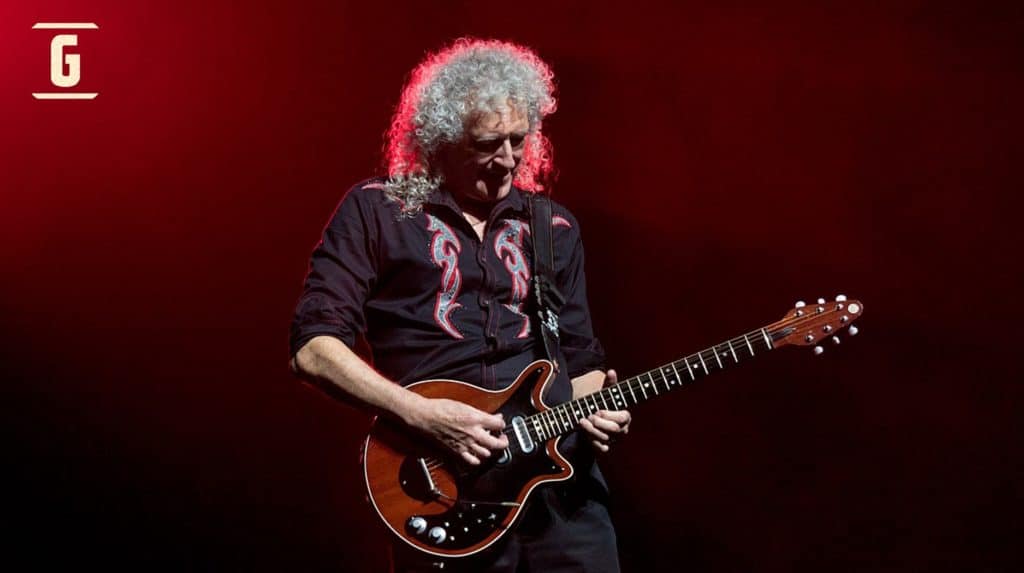
Red Special is the name of the mythical guitar of Brian May, Queen’s guitarist, which was built by him together with his father, we tell you its history and secrets.
Why did Brian May build the Red Special?
It was 1963, Brian May at that time was 16 years old and played an acoustic guitar that his parents had given him, which he still has today. But to play the music he wanted he needed an electric guitar. Unfortunately, his family couldn’t afford a Fender Stratocaster or a Gibson Les Paul.
Harold May, Brian’s father, was an electrical engineer and a great builder, a true craftsman. So father and son discussed building an electric guitar themselves. Brian even says they said, “Maybe we can do something better than anyone has ever done.” In this way, both began an ambitious project, which meets Brian‘s own requirements and is of the highest quality and with cutting-edge concepts. Thus, it was that the Red Special was built unique in its kind. The construction process took about a year and a half, beginning in August 1963, ending in 1964. Let’s look at Brian May’s fascinating guitar history, the Red Special.
What is the name of Brian May’s guitar?
The name of Brian May‘s electric guitar is Red Special, but it also has other nicknames such as The Old Lady and also The Fireplace, since it was made with a part of a hearth from an old house.
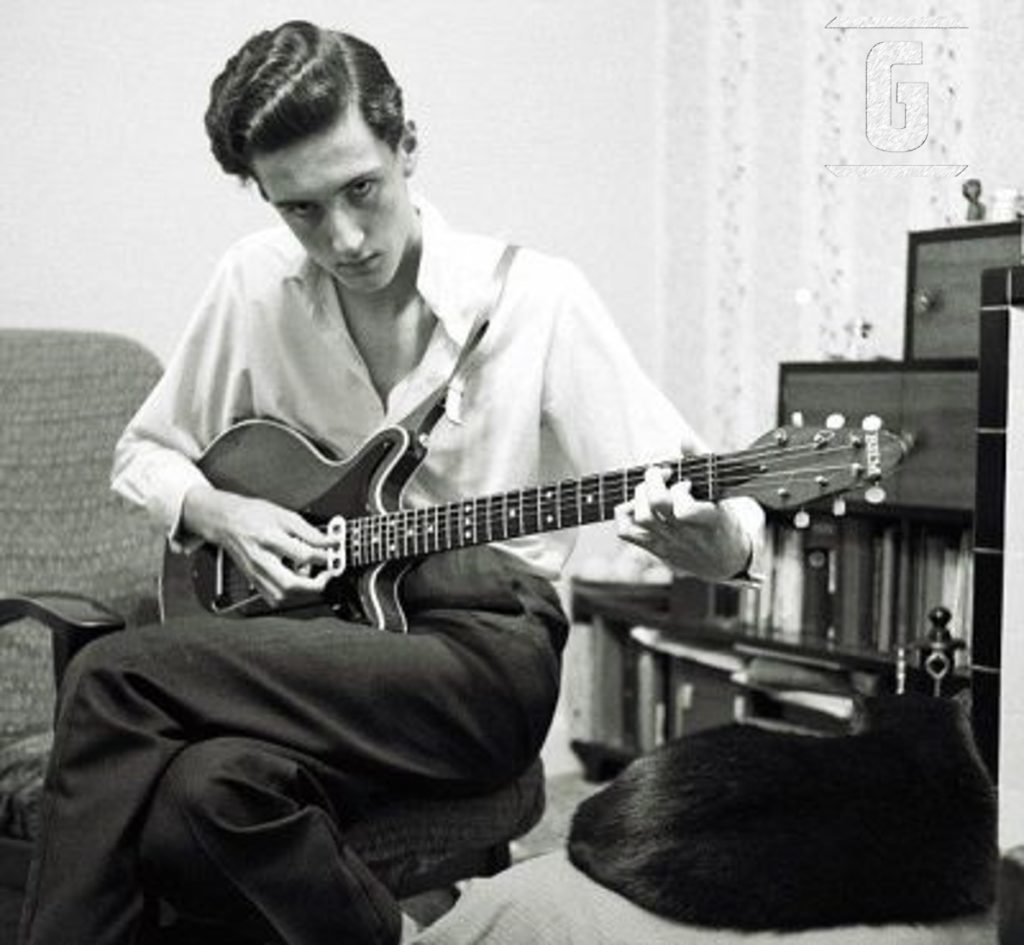
made by him and on the headstock the initials: BHM by Brian Harold May
You may also be interested in the history of Eric Clapton’s Blackie Stratocaster.
Characteristics of the Red Special
Red Special, a true DIYer guitar
One of the most amazing things about this guitar is that it was made mostly from recycled materials that the Mays had on hand, using rudimentary and simple tools.
With the exception of the frets and the pegs of the guitar, which were bought at a store near the house, all the components were designed and manufactured by Harold and Brian May. The bridge, tremolo, and other pieces were made by themselves. The guitar pickups were initially made by them, but later they bought the definitive ones, three Burns pickups which Brian rewound and modified.
A recycling product
The main materials with which the guitar was built were things that they had on hand. The neck of the guitar is constructed from the wood of an old mantelpiece that was over 100 years old at the time. Also, the guitar’s inlays and tremolo lever cap are made with buttons and a knitting needle from the musician’s mother. For the body of the instrument they used parts of an old table. For the binding of the guitar body, they used white plastic from some shelves.
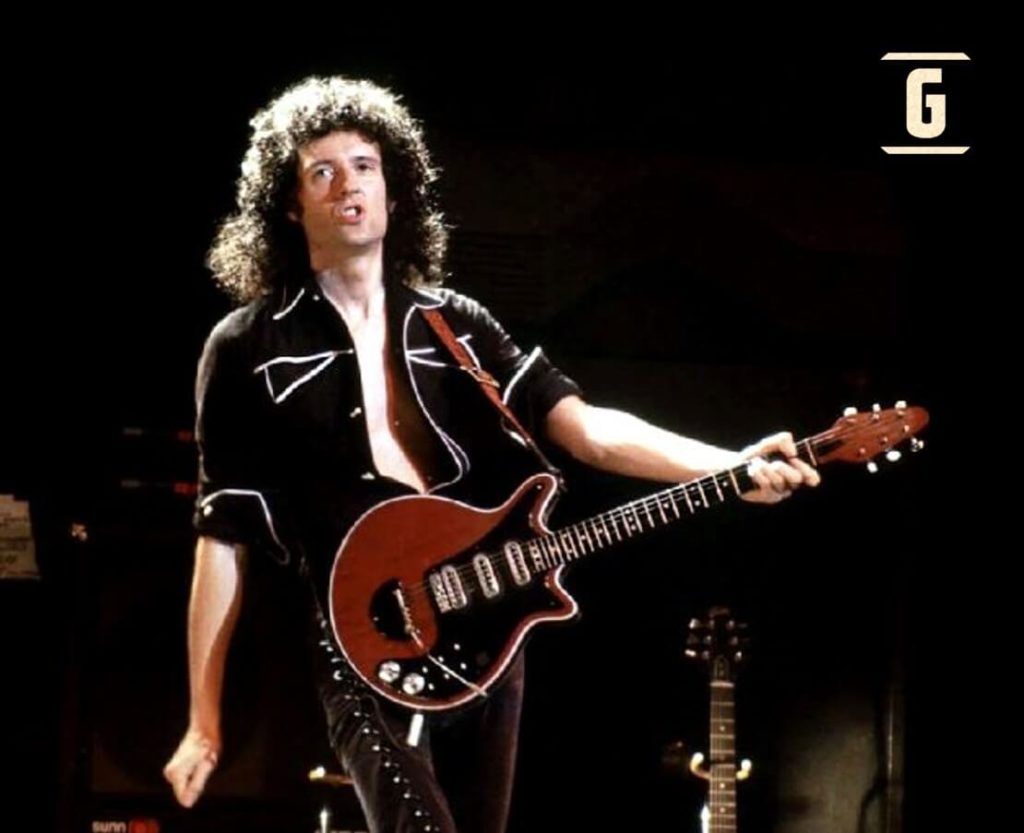
The Red Special, an avant-garde instrument
Although the fact that most of the guitar was made by hand and with recycled materials is really remarkable; Probably the most surprising and admirable is the quality, design and cutting-edge concepts with which the Red Lady was built.
The first example of the high level of innovation and engineering that goes into this iconic guitar is the roller bridge and zero fret to minimize friction when using the tremolo. In this way, the tuning of the guitar is not affected by sudden changes in tension due to “leverage”.
Another excellent example is the 24 frets that the guitar has. Something very rare then, and even today considering that it has a scale of only 24 inches.
The variety of audio on the Red Special guitar remains remarkable even today. Featuring three ON/OFF switches and three independent Phase / Out of Phase switches for each of the guitar’s three pickups, they provide a variety of exceptional tones. In this way you can achieve sounds similar to a Strat by connecting a single pickup or the neck and middle combination, while when connecting all three you can achieve the gain of a Les Paul.
Red Special, a unique guitar for an extraordinary guitarist
Brian May‘s signature audio comes from this unique guitar plugged into the Normal channel of a Vox AC30, the Sixpense coin for a pick, and of course Brian’s fingers.
May made this whole guitar to the specifications of his own taste and desire, for example, one of the things he looked for was feedback. Brian has confessed that playing with it fascinates him. For this he was inspired after seeing Jeff Beck playing live and making different sounds simply by moving the guitar in front of the amplifier. He wanted an instrument that was alive and interacted with him and the air around him.

Brian has used the Red Special almost exclusively and uniquely on Queen albums and in live performances since the band’s inception in the early 1970s. Virtually all Queen songs are recorded on this instrument except from Crazy Little Thing Called Love, which used the effective old Telecaster guitar and some tracks recorded with acoustic guitars.
Brian has told several times that when he started touring, a friend of his who was a journalist told him not to take the Red Special. The guitarist told him that he couldn’t, that if he didn’t take it, a part of him was missing. Fortunately, the “Old Lady” has survived all those trips, remaining in excellent functional condition.
Don’t miss the incredible history of David Gilmour’s Black Strat.
Construction of the Red Special
Building the guitar was hard and difficult work. Brian May himself has said that they did not have sophisticated tools. The few they did have were simple household tools, such as chisels, penknives, sandpaper, etc., and even, in some cases, he and his father had to build their own specific tools themselves in order to proceed with the construction.
An anecdote told by the musician that illustrates how difficult the process was was the time that while working on the oak of the guitar body, Brian damaged part of the wood using the chisel. The teenage guitarist got so frustrated and angry that he threw everything out the window, then, calmer, went back to work.
Another example that May has commented on is that for the neckpocket of the guitar, the part of the body where the neck is embedded, and for the heel of the neck, the part that is inserted into the body, all the tools he used were a penknife and a sandpaper.
General specifications of the Red Lady
The Red Special also known as The Fireplace or The Old Lady, is a guitar with a mahogany neck with an oak fretboard screwed to a hollow body made of oak, pressed wood, an aesthetic mahogany veneer and double border.
Brian May’s guitar has a short scale of 24″ and 24 frets without considering the zero fret. It has a tremolo system and a roller bridge designed by Brian and his father, which works perfectly.
The guitar’s pickups are three Burns Tri-Sonic with independent activation and switches that allow them to be connected in phase or out of phase, giving a large amount of available audio.
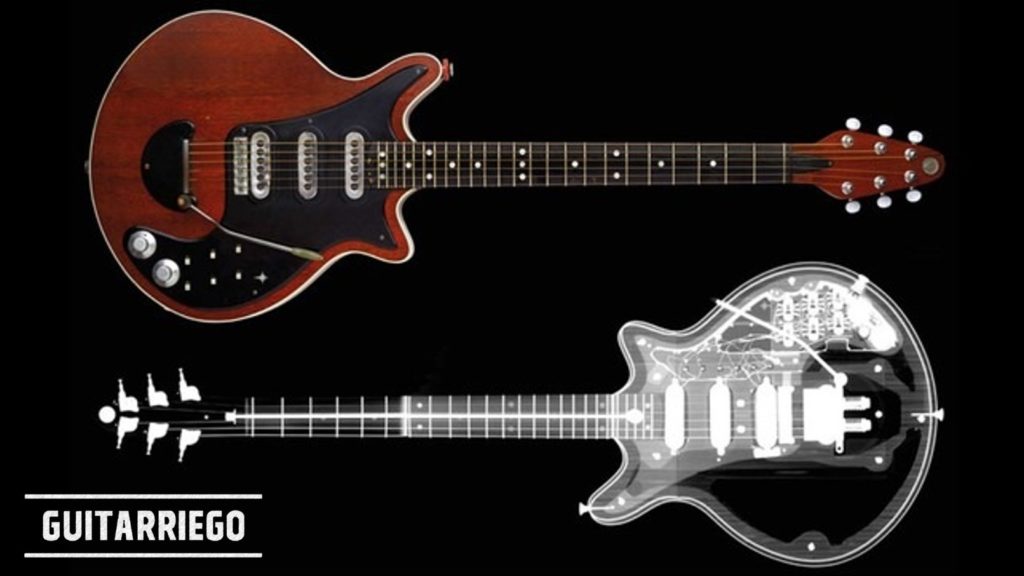
Neck of the Red Special
The neck of the Red Special was made from mahogany from a mantelpiece. This plank of wood was approximately 100 years old, more than enough time for a good parking and drying of the wood without question. The wood was a moth-eaten mahogany, however Brian and Harold May saw the potential in that ancient wood.
Neck profile of the guitar was worked by hand until Brian desired shape, a job made difficult by the age and quality of the wood. The guitarist has explained that the holes made by bugs were covered with matches and a layer of Rustin’s Plastic Coating.
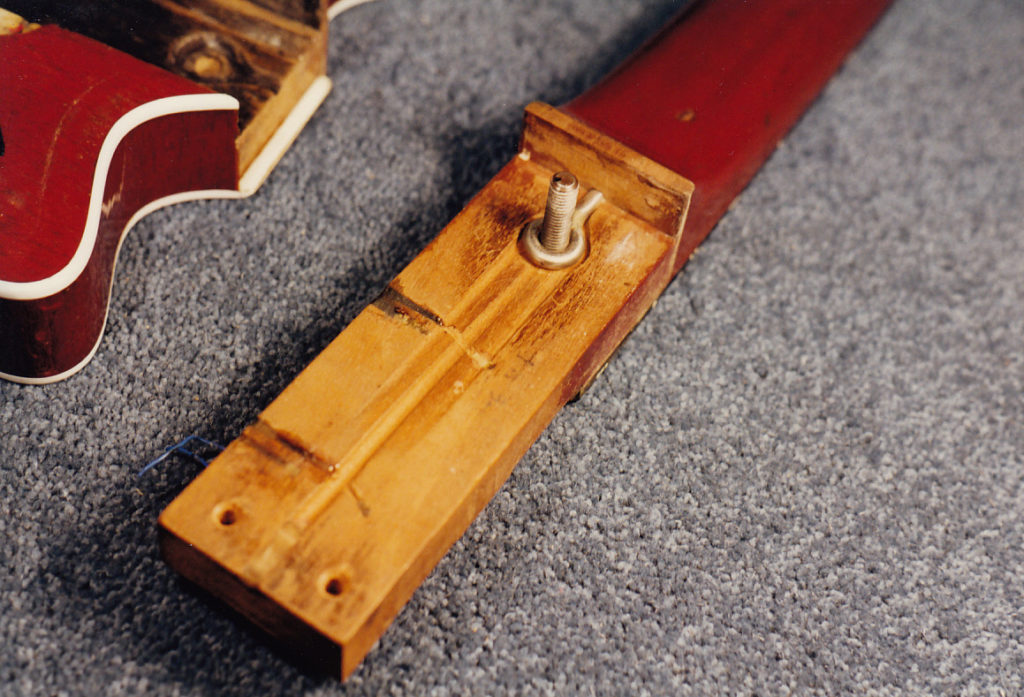
For the guitar’s truss rod, Brian and Harold heated one end of a steel rod, then bent it into a hook. This hook is screwed into the heel of the guitar neck, while the rest of the bar goes through the neck to the headstock.
We recommend that you visit this article on the rarest guitars in the world.
Fingerboard of the “Fireplace”
The neck has an oak fretboard painted black, simulating ebony. Oak is a light-colored wood, not widely used for guitar fingerboards. In contrast, ebony is a premium and very expensive wood. It has 24 frets, something very innovative and even today it is still rare considering that the guitar is built with a short scale of only 24 inches. The guitar still retains the original frets, at least that’s how it was until 2014, the year in which the Queen guitarist told Absolute Radio in an interview.
The fretboard radius is 7.25″, like the Fender of the time. Each of the inlays on the guitar neck are mother-of-pearl buttons given to him by his mother. Brian May, giving it a personal touch, decided to position them in an original way: two dots on the 7th and 19th frets and three on the 12th and 24th.

Guitar Nut: Red Special Zero Fret
Another incredible piece of Brian May‘s ingenuity and innovation is that instead of a standard nut, he incorporated a zero fret along with a Bakelite string guide, similar to a nut so that the strings glide smoothly when using the tremolo. In 2005, the “Old Lady” has received a new zero fret.
Headstock of the “Old Lady”
The headstock of the guitar is designed to maintain as little friction as possible on the strings, achieving almost a straight line. In this way Brian made the entire tremolo system and tensions of the instrument work perfectly, with minimal friction, without affecting the tuning.

Body of the “Old Lady”
The center of the body is made of oak taken from an old table. Brian May says that the wood was very difficult to work with because it was “as hard as steel”. The body outline is made of pressed wood, ie interleaved softwood strips glued together.
Finally, to give it a better appearance, the body is covered with mahogany veneer or marquetry veneer on the top, bottom and sides that give it that image of a solid mahogany body guitar.
Semi Hollow Body
The body of the Red Special, in addition to having a large cavity for the controls, also has an acoustic chamber on top of the body. The end result was technically a semi-acoustic guitar. Brian May says this allows him to have a more “live” interaction with the amp, and gives him the ability to play feedback with the amp, taking inspiration from Jeff Beck.

Brian May has said that originally the idea was for the guitar to have f-holes, but he never did.
The musician then attached a white plastic shelf trim to the top and bottom edges to make the bindings, giving it a sleek, high-end guitar look.
Also, you may be interested in seeing Gibson’s Worst Failures: Forgotten Guitars.
Red Special guitar pickups
The guitar has three singlecoil pickups. Originally, the guitar had pickups made and wound by Brian, which he said sounded good. The problem was that when he did bendings they had a strange behavior and sound. So later he ended up buying some Burns Tri-Sonic pickups. Two of these he rewound and coated the coils with Araldite Epoxy to reduce microphonics. The middle guitar pickup remained uncoiled and uncoated.
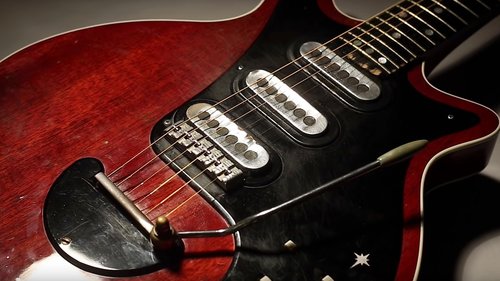
In the 1980’s DiMarzio examined the guitar pickups to design ones for the first replica of the Red Special made by Guild. At that point, the magnet was rotated to change its polarity and the wires soldered to the posts were swapped to mimic a reverse wound coil. This made Brian May‘s preferred combination of bridge and middle pickups in phase humbucking.
Pickup switches on Brian May’s electric guitar
The pickup selection system is one of the most notable differences between the Red Special and any other guitar. Most guitars have a three or five position selector switch to select between one of two or three pickups. The “Old Lady” has six switches!

Brian tried different wiring configurations for the guitar pickups. The Red Special pickups can be connected in parallel or series, and connected in phase or out of phase.
Brian May couldn’t decide on just one or two setups. That was how he and Harold created an array of switches that gave him more flexibility. The pickups are wired in series. Top row of switches turns each of the three pickups on or off. Bottom row of switches reverses the polarity of each pickup, changing the phase. In this way the guitar achieves audio versatility. It’s not uncommon for Brian to change settings during a song. In fact, while he used almost every combination for Bohemian Rhapsody recording.
Brian May guitar bridge
The bridge is custom made in aluminum by Brian May himself. To reduce friction, the bridge has been completed with rollers to allow the strings to return perfectly in tune after using the tremolo. In this way, Brian eliminated the problem that tremolo systems usually have that don’t return to their initial position, affecting the tuning of the musical instrument.
Brian made each of the rollers using a hand drill like a kind of manual lathe. The rollers are not attached to the bridge, so every time a string is cut during a recital it means a roller falls off and is lost. So he needs to have spare rollers on hand at all times.

Red Special Tremolo
The tremolo system is made of old hardened steel with a V-shape and blade edge and two motorcycle engine valve springs -some say they’re from a Norton while others claim they’re from a 1928 Panther- to counteract the tension of the strings which is 36 kilograms or 79 pounds.
The spring tension can be adjusted via screws, which run through the middle of the springs, in or out through two small access holes next to the rear strap button.
Father and son did three tests before settling on the final design. Friction is minimized with Zero Fret, the alignment of the strings with the headstock and the rollers on the guitar’s bridge.
The tremolo lever is made from a bracket from a bike rack with a knitting needle point that belonged to Brian’s mother.
This system was an innovative and effective design, so Brian has been suggested many times to patent it, but according to the musician: “patents are a pain in the neck, and why not share everything with the world?”
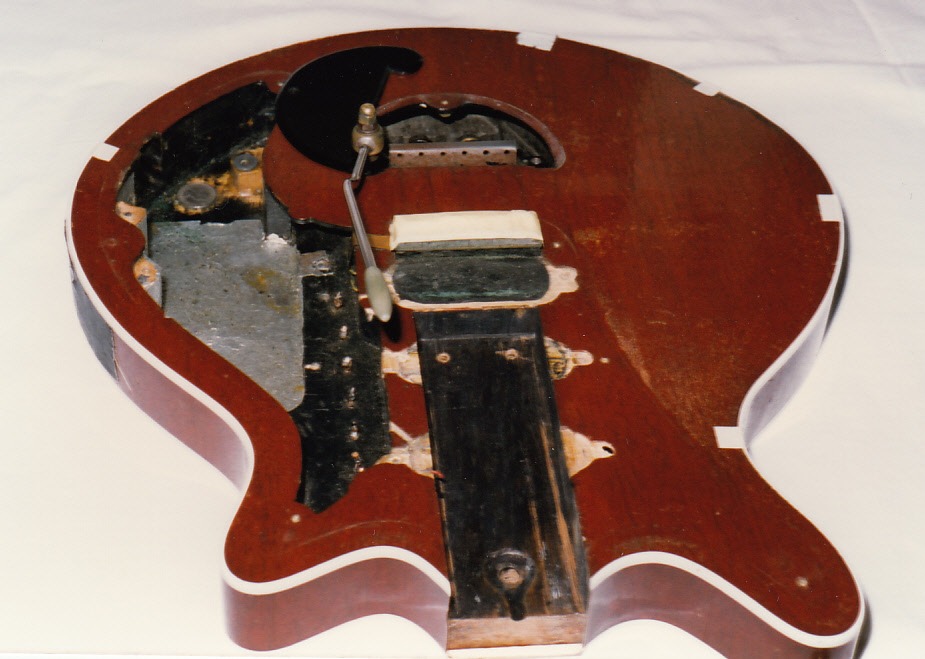
Built-in distortion circuit
Originally, the guitar had a built-in distortion circuit. Brian took a Vox fuzz and adapted and installed it inside the body. The switch was next to the pickup switches. Later, May found that he preferred the sound of a full power Vox AC30 distorting. So he ended up removing the circuit. The switch hole is now covered in a mother-of-pearl star inlay, though for a time it was covered in electrical tape.
Also, you may be interested in Fender’s Biggest Failures: Guitars Nobody Wanted to Buy.
Brian May’s Red Special book and its history
In 2014, in celebration of the instrument’s 50th anniversary, May, along with Simon Bradley, wrote a book on the construction and history of Brian May’s guitar: “Brian May’s Red Special: The Story of the Home-made Guitar That Rocked Queen and the World.“
Video of the presentation of the book of the «Brian May Red Special» and its history
The restoration of the Red Special
In 1998, Brian May took the Red Special guitar to an Australian luthier, Greg Fryer, to tune it up. They discussed about whether or not they should restore it. The musician did not doubt it, and he commissioned Greg to restore it.
Greg reported that the neck was straight, even though the truss rod had never had to be adjusted in the entire history of the Red Special, which was over 30 years. It must be considered that the neck of the guitar is made of wood that is over 150 years old and of large dimensions. Thus, the string tension does not affect it.
You can see photos of the restoration of the Red Special on Greg Fryer’s site.
But the Red Special‘s restoration and tune-up was not the only job Brian May gave Greg Fryer. He also asked him to build two replicas of the Red Special that Brian would use as a spare for his much-demanded and beloved “Red Lady”.
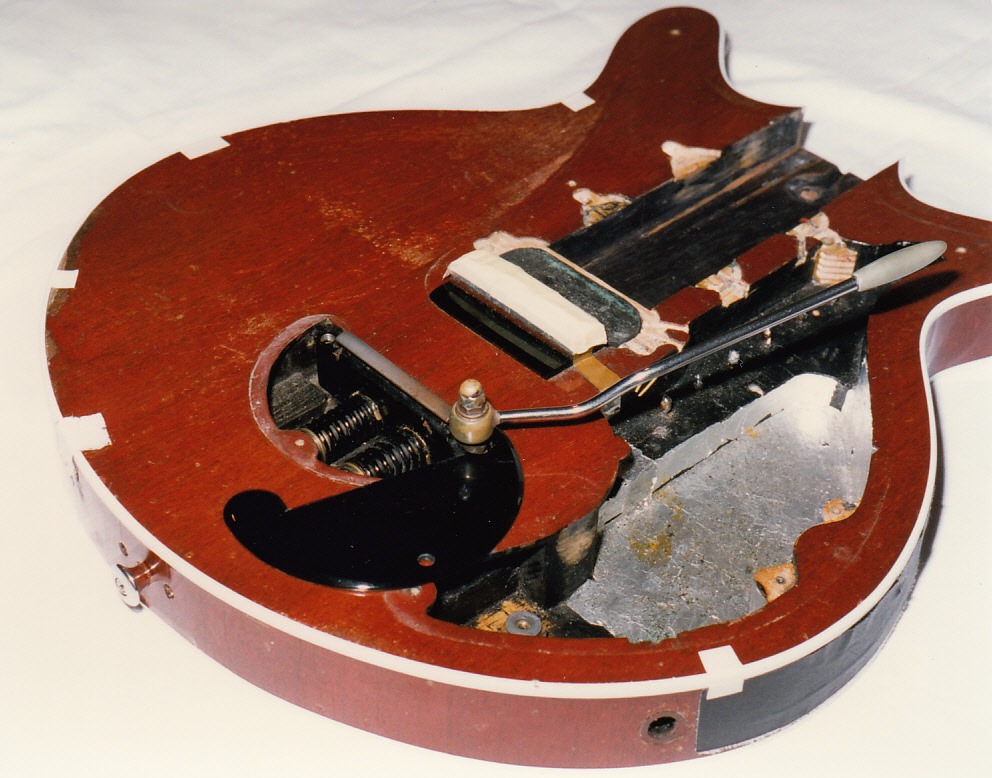
Brian May and the Red Special, an inseparable couple
Brian May, despite all the warnings, takes the guitar everywhere he goes to play, wherever it is. His set is completed with various replicas that he also alternately uses in his performances, some acoustic guitars and Telecaster.
But like everything, there are a few exceptions in which May does not appear with his beloved Red Special in the history of the legendary British band Queen.
Opportunities in which he did not use the Special
There is one occasion where the Old Lady was not used, and that is in the videos for “We Will Rock You” and “Spread Your Wings” which were filmed together. The videos were shot in the snow and the guitarist did not want to expose the Red Special to such conditions. In its replacement he used a copy built by the luthier John-Birch. Said guitar was made entirely of maple with a finish that looked like natural wood. It was also used as a backup in recitals, until Brian May destroyed it during a performance.
Another time the Red Special was not used was in the “Play the Game” video. Instead he used a cheap replica of a Fender Stratocaster, as at one point in the video, Queen singer Freddie Mercury snatches the guitar from Brian May and then throws it back at him.
Another video in which the Red Special does not appear was that of “Princes of the Universe”. In this video the musician used a white Washburn RR11V. The reasons are unknown. The instrument is often mistaken for a Jackson Randy Rhoads. He also recorded the original “Crazy Little Thing Called Love” with Queen drummer Roger Taylor’s Fender Esquire; but he filmed the video and live performances of the song until 1992 with a Fender Telecaster.
Without a doubt, the history of the Red Special guitar is fascinating and captivating.
Don’t miss this note of the best electric guitars of all time.
The Red Special and its replicas
In Brian May’s “Rig Rundown” that Premier Guitar did on Queen‘s 2014 tour, you can see the guitars that the musician plays.
The musician has, of course, the Red Special, with which he plays most of the songs. The second guitar, which is the spare in case he cuts the string with the Red Special. It is one of the replicas made by Greg Fryer, a fairly faithful replica of the Red Lady. This guitar is only used when the Old Lady breaks a string and until his technician puts a new string on it.
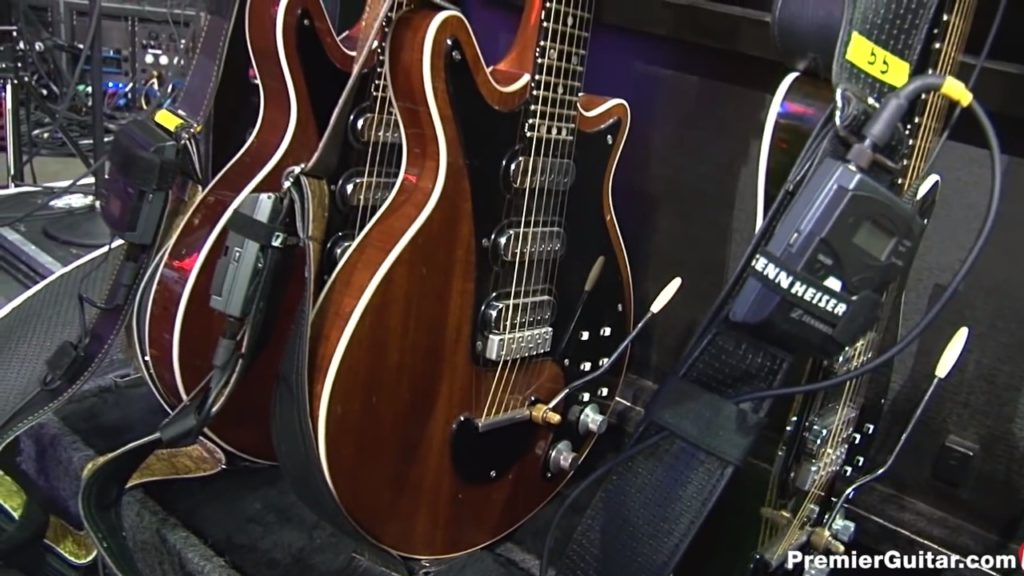
Technician Pete Malandrone says that Brian May uses 0.09 caliber string. Quite light, but he used to use 0.08 before but cut string a lot, especially since he plays with a coin instead of a guitar pick. He clarifies that he holds the coin very lightly, that’s why he drops a lot of coins, probably about 10 a night he claims.
The third guitar is another replica of the «Old Lady» made by the English luthier Andrew Guyton. It is a «Green Special» since it has a green finish. The Green Special is tuned to Drop-D and is used only for the song “Fat Bottomed Girls”. The fourth guitar is another Greg Fryer that is also tuned to Drop D and is the replacement for the green one. A particularity of this guitar is that it has slightly hotter pickups than the rest.
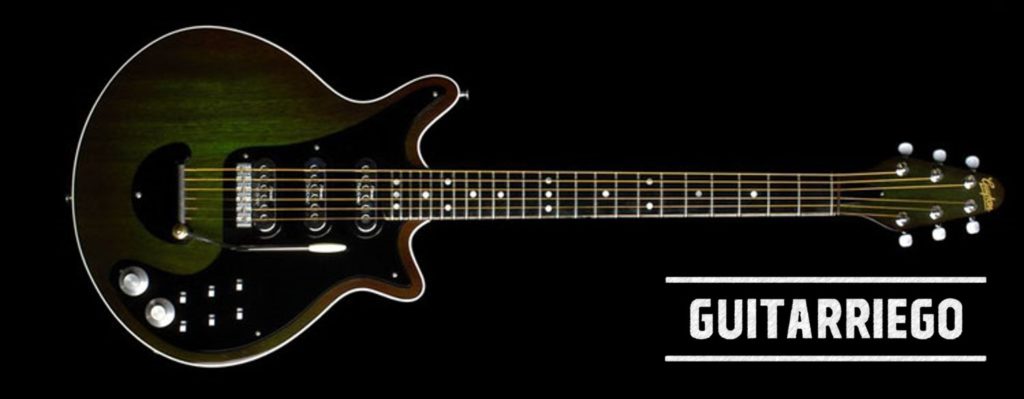
The Queen’s jewel, the Red Special Guyton “Boutique”
The fifth and last guitar is another Guyton, it’s a “Red Special replica” but “Boutique”. This instrument is a true beauty with particularities that make it unique. The first particularity is that it has an arched top, instead of the classic flat one. The top of the guitar is made of very colorful quilted maple. Also, it has an f-hole, as was the original design of the Red Lady. Very striking that the pickguard is also arched. Finally, it has a fixed bridge and internal piezo pickup. Brian May uses this guitar only for “Crazy Little Thing Called Love“.
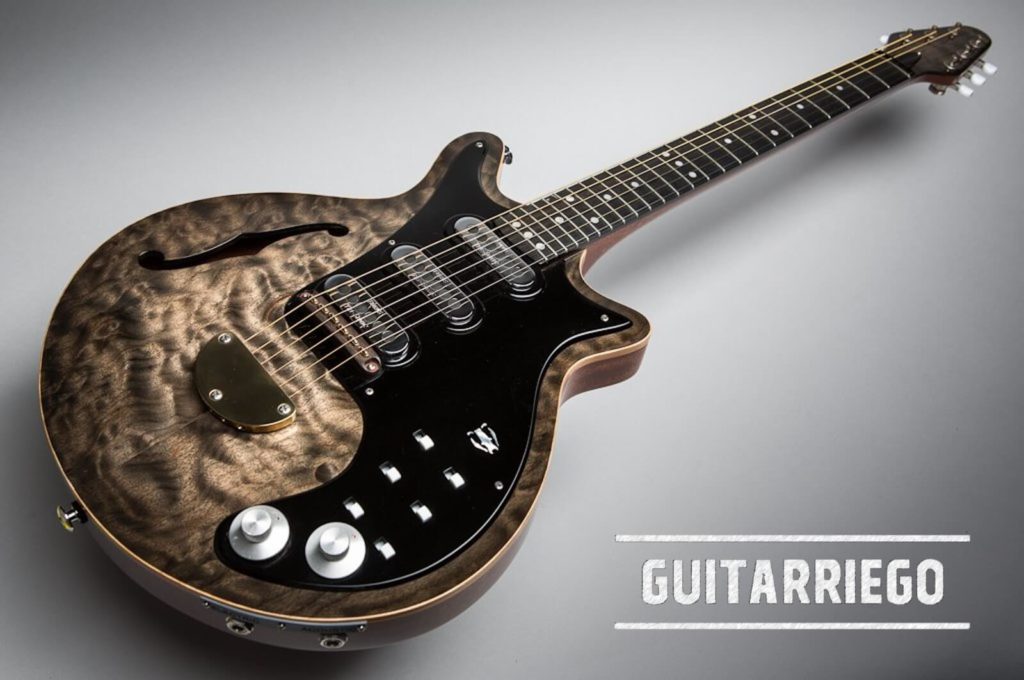
Do you know anything else about Brian May’s Red Special? Share it with us in the comments section below.
Note related to Brian may: The story of the mythical Vox AC15 and AC30 amplifiers.







Yes, I read about Brian throwing everything out the window years ago. To my memory, he had to start all over again, but I can’t remember where I read it to be sure.